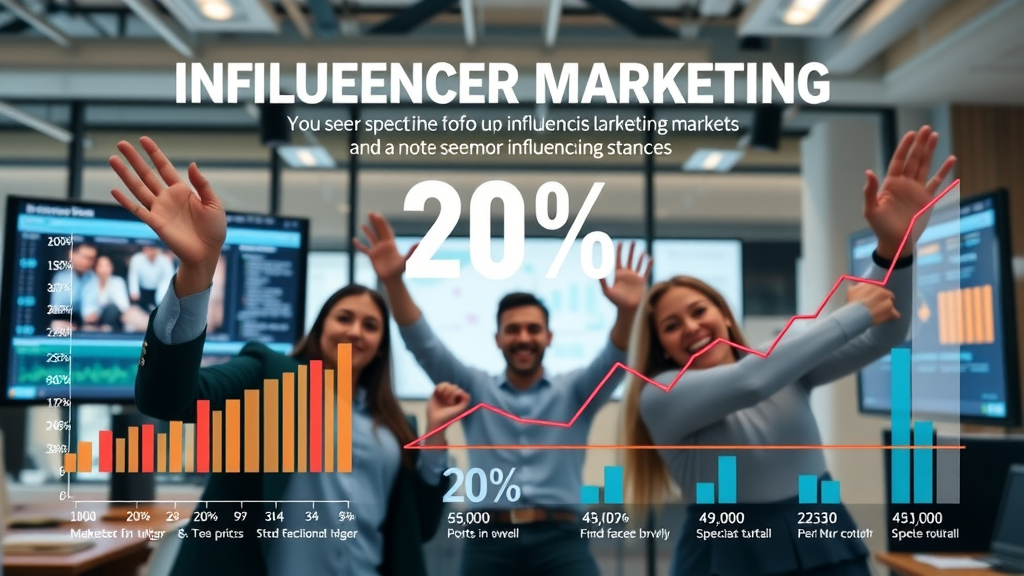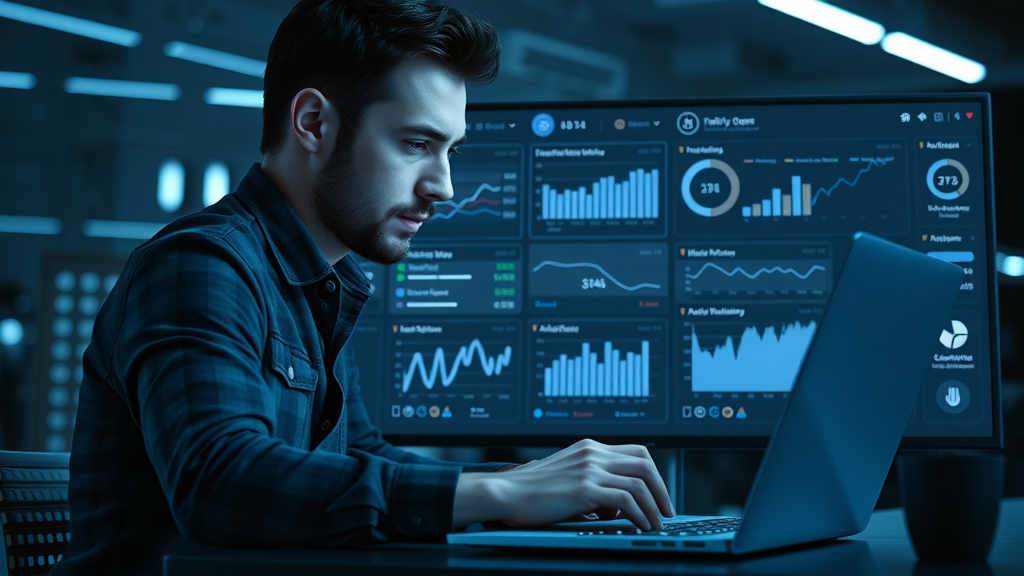Hook: Did you know that over 80% of marketers believe influencer marketing delivers better ROI than traditional advertising? With digital attention shifting from TV commercials to the power of trusted social media personalities, mastering influencer marketing could be the edge your brand needs to explode its reach and conversions. Read on to discover exactly how top brands ride the influencer wave—and how you can too.
Startling Stats: Influencer Marketing’s Explosive Growth and Impact

Over the past decade, influencer marketing has skyrocketed to dominate the social media marketing landscape. According to recent reports, global spending on influencer marketing campaigns will surpass $21 billion in 2024, doubling in just three years. This meteoric growth is driven by businesses seeing an average of $5.78 earned media value for every $1 spent on influencer collaborations.
Brands are no longer simply purchasing banner ads or sponsored posts. Instead, they’re tapping into the credibility, reach, and authenticity of social media influencers to connect with loyal niche communities around the globe. By leveraging top influencer marketing platforms , marketers can now measure campaign performance, track true ROI, and build the brand trust that modern consumers expect.
Did you know that over 8 out of 10 marketers now allocate a dedicated portion of their marketing budgets to influencer campaigns? As brands compete for attention in crowded digital feeds, influencer marketing offers a proven way to cut through the noise, drive meaningful engagement, and even accelerate sales far beyond traditional ad channels.
Comprehensive Guide to Influencer Marketing Success
- Understand the foundational principles and best practices driving influencer marketing
- Learn how to select the right social media influencers and platforms for your brand
- Unlock key strategies for executing a powerful influencer marketing campaign
- Measure results to refine your marketing strategy and maximize ROI

What is Influencer Marketing and Why Does It Matter in Social Media?
Influencer marketing is the strategic practice of partnering with individuals—called social media influencers or media influencers —who have dedicated online followings to authentically promote products, services, or brand stories. Unlike traditional ads, influencer campaigns thrive on trust, relatability, and personal connection. In a world overflowing with content, consumers increasingly tune out direct ads but pay close attention to endorsements from people they follow and trust.
Through media marketing , influencer partnerships drive up engagement rates, boost brand awareness, and spark real conversations in ways banner ads never could. When you match your brand with the right influencer marketing platform and voices, every story told reaches deeper, resonates louder, and earns more credibility among targeted digital communities.
In comparison to standard media marketing methods, influencer marketing campaigns excel at driving conversions. Their content creation is tailored to audience interests, sparking genuine interactions that can take your marketing strategy from stalled to soaring.
Influencer Marketing Strategy: Crafting Your Roadmap to Success
Setting Objectives for Influencer Marketing Campaigns
A successful influencer marketing strategy starts by defining crystal-clear objectives. Are you aiming for broad brand awareness , a spike in social media followers, deeper audience engagement, or direct conversions? Your goals dictate the entire direction of your influencer marketing campaign.
For instance, if your brand is new, focusing on media influencers with a large reach can maximize exposure. But if you want to drive sales for a niche product or service, collaborating with micro influencers who have a loyal, targeted following can heighten engagement and conversion. Importantly, set measurable metrics—such as follower growth, engagement rate increases, or referral conversions—so you can objectively track campaign performance and iterate your marketing strategy for future success.
Aligning these influencer marketing campaign objectives with your broader social media marketing strategy ensures every post or story amplifies your brand’s mission and delivers the results that matter most.
Finding the Right Influencer Marketing Platforms
With so many marketing channels—from Instagram and YouTube to TikTok and LinkedIn—the right influencer marketing platform or social media outlet is crucial. Start with an in-depth review of where your target audience spends the most time and which content types (video, image, stories, long-form posts) they engage with most.
Compare top-tier influencer marketing platforms designed to facilitate influencer discovery, direct messaging, performance tracking, and payment management. Assess how each platform’s unique features—such as advanced filters, analytics dashboards, and campaign management tools—fit your intended marketing campaign. The perfect platform supports both your campaign objectives and the day-to-day logistics, unlocking scale and efficiency as your influencer marketing efforts grow.
Ultimately, choosing the right social media marketing channels and platforms can be the difference between scattered messaging and a powerful, integrated influencer marketing campaign that delivers lasting brand impact.

Types of Influencers: Choosing the Perfect Media Influencer for Your Campaign
Mega Influencers, Macro Influencers, Micro Influencers, Nano Influencers
| Type | Follower Count | Best Use Case |
|---|---|---|
| Mega Influencers | 1M+ followers | Massive reach, global campaigns |
| Macro Influencers | 100K–1M followers | Large niche audiences, broad campaigns |
| Micro Influencers | 10K–100K followers | High engagement, targeted niche |
| Nano Influencers | 1K–10K followers | Authenticity, local drives |

The types of influencers you choose can make or break your influencer marketing campaign. Media influencers are typically categorized into four groups, each offering unique value.
Mega influencers (“celebrity” influencers) wield unmatched global reach—ideal for mass awareness or product launches. Macro influencers can spread your message to large niche audiences, balancing reach with stronger engagement. Micro influencers often have the highest engagement rates and can convert their tight-knit audiences with authentic, accessible content. Nano influencers , though smallest in follower count, authentically champion brands to local or ultra-specific communities, producing high resonance at lower costs for emerging brands.
Selecting the right blend of mega, macro, micro, and nano influencers depends on your marketing strategy, goals, and budget. For layered campaigns, many brands blend influencer types: mega for buzz, micro for conversions, and nano for localized endorsements. This diversified approach amplifies both reach and relevance, leveraging influencer collaborations for maximum impact.
Designing a High-Impact Influencer Marketing Campaign
Building Strong Relationships with Social Media Influencers
The backbone of every effective influencer marketing campaign is a strong, mutually beneficial partnership with social media influencers . To forge successful influencer collaborations, brands must go beyond one-off transactions. Take time to research influencers’ values, audience insights, and prior brand campaigns. Reach out with a personalized message that shows you understand their platform, content creation style, and influence.
Set expectations early—define campaign deliverables, timelines, compensation, and brand guidelines in a transparent, written brief. Encouraging open feedback, creative input, and timely communication ensures influencers feel respected and empowered to do what they do best. Treating influencers as valued partners, not just marketing tools, strengthens relationships, encourages authentic endorsements, and sets the stage for repeat campaigns.
Creative Content Creation Strategies for Influencer Marketing
Compelling, brand-aligned content creation is central to any influencer marketing strategy. Collaborate closely with your influencers, tapping into their knowledge of what resonates best with their specific audience segment. Equip them with guidelines and campaign objectives, but allow for flexibility and authenticity in their posts. Audiences crave relatable, personal stories and behind-the-scenes creativity—not scripted advertisements.
Leverage a mix of content formats: micro-videos, Instagram Stories, YouTube tutorials, blog posts, or even live events. Maximize your influencer marketing platform’s content curation tools to repurpose top-performing influencer posts for broader marketing campaigns or multi-channel use. The result? High-performing, evergreen brand assets that amplify your message and marketing investment over time.

Top Influencer Marketing Platforms and Tools
Comparing Influencer Marketing Platforms to Boost Results
| Platform | Key Features | Pricing |
|---|---|---|
| AspireIQ | Automated tracking, reporting, influencer discovery | Subscription |
| Upfluence | Database search, CRM, analytics | Quote-based |
| CreatorIQ | Integration, workflow automation, performance tracking | Enterprise |
| Influencity | Advanced filtering, campaign management | Free trial, paid plans |

Dozens of influencer marketing platforms now power every stage of campaign execution, from influencer discovery to reporting. AspireIQ and Upfluence excel at influencer search, automated outreach, and tracking key metrics such as engagement rate and follower count. CreatorIQ is ideal for enterprise-scale influencer marketing campaigns, while Influencity offers scalable solutions for agencies and SMBs.
Compare the advanced features—database size, analytics depth, integrated content creation tools, and CRM—against your marketing strategy and goals. The right marketing platform transforms influencer management from a manual process into a growth engine, unlocking scale, transparency, and actionable insights at every campaign stage.
The 3 Rs of Influencer Marketing: Reach, Relevance, Resonance
- Reach: How many people can your influencer connect you with?
- Relevance: Does the influencer’s audience align with your brand message?
- Resonance: What level of engagement and impact does the influencer deliver?
Every influencer marketing campaign should be planned and evaluated through the lens of the “3 Rs”—Reach, Relevance, and Resonance. Reach is the potential audience size delivered by your chosen influencers (think follower count and platform reach). Relevance gauges how closely an influencer’s audience and content align with your brand’s message, product, or niche. Resonance measures the real impact—engagement rate, shares, comments, and the likelihood of action or conversion.
Successful campaigns balance these elements, selecting influencers who not only have impressive numbers but also genuine sway in audiences that matter for your marketing strategy. Prioritizing all three Rs unlocks stronger returns, more meaningful engagement, and a marketing investment that generates compounding results for your brand.
Measuring Success: Key Metrics for Influencer Marketing Campaigns
Follower Count, Engagement Rate, Conversion, and ROI
"Marketing without data is like driving with your eyes closed." – Dan Zarrella

To truly master influencer marketing , you must embed measurement into every campaign. Track core metrics including follower count (total audience), engagement rate (likes, comments, shares), click-through rates, conversions (purchases or signups), and ROI. Modern influencer marketing platforms offer analytics to benchmark performance against pre-set objectives, making it possible to separate hype from real business impact.
Beyond surface-level stats, evaluate qualitative outcomes like brand sentiment, earned media coverage, and User-Generated Content (UGC) created by your influencer’s followers. Consistent tracking and performance reviews allow teams to refine creative tactics, optimize media spend, and scale top-performing influencer collaborations.
Case Studies: Real Brands Winning with Influencer Marketing
- How a global beauty brand increased sales by 50% through targeted social media influencer partnerships
- The story of a fitness company leveraging micro influencers to infiltrate new markets
- A retail brand’s journey scaling awareness with a multi-platform influencer marketing campaign

These real-world examples illustrate the power of strategic media influencer partnerships. From beauty brands collaborating with mega influencers for international launches to niche fitness companies skyrocketing regional sales via micro influencers , the possibilities are endless. The key lies within matching your marketing goals to influencer strengths—facilitated by robust influencer marketing platforms and sound analytics—to repeat and scale success.
Budgeting for Influencer Marketing: What Does It Really Cost?
Understanding costs is essential for any influencer marketing strategy. Influencer payment models range from flat fees per post or story, to performance-based incentives tied to sales, clicks, or other campaign KPIs. On average, nano influencers may charge $50–$100 per post, while macro and mega influencers often require $1,000–$10,000 (or more) for campaigns running across top influencer marketing platforms.
Many brands partner with an influencer marketing agency for large-scale or multi-platform campaigns, negotiating not just rates but also creative deliverables, content rights, and exclusivity. Budget flexibility is important as costs also vary by platform, niche, and timing—so always set expectations in a formal campaign agreement to avoid costly miscommunications.

Legal and Ethical Considerations in Influencer Marketing
To ensure campaign safety and trust, brands must comply with all legal and ethical guidelines around sponsored content. The FTC requires clear disclosures for paid partnerships—usually as #ad or #sponsored—so audiences are aware of promotional relationships. Influencer marketing agencies and brands alike must also keep records, monitor compliance, and provide guidance to social media influencers on disclosure requirements.
Protect your brand by working with legal or compliance experts, using influencer marketing platforms equipped with compliance features, and collaborating only with professional influencers who adhere to advertising best practices. Smart, ethical marketing campaigns safeguard both your reputation and your influencer relationships.

Maximizing Results: Best Practices for Social Media Marketing and Influencer Collaboration
- Clearly define deliverables in your influencer marketing campaign brief
- Maintain ongoing communications with influencer marketing platforms and talent
- Leverage analytics to iterate social media marketing strategies
- Reward successful partnerships with long-term collaboration opportunities
To ensure every influencer collaboration delivers full value, follow these actionable best practices. Start with a well-drafted campaign brief—details reduce confusion and empower influencers to deliver tailored, impactful content creation. Maintain frequent, respectful communication so issues are quickly addressed and creative ideas flourish.
Use analytics from your marketing platforms to optimize both messaging and spending. Finally, nurture winning partnerships with repeat opportunities, preferential rates, and product access to build loyalty among high-performing creators. These steps lay the groundwork for a robust, future-ready influencer marketing strategy.
People Also Ask: Answering Common Influencer Marketing Queries
What does influencer marketing do?
Influencer marketing leverages trusted personalities on social media who have loyal followings to deliver your brand’s message, increase awareness, foster trust, and boost engagement or conversion rates through personalized content. The best influencer marketing campaigns connect brands to target audiences efficiently and authentically, resulting in higher engagement and measurable business growth.
What are the 4 types of influencers?
The four main types of influencers are mega influencers , macro influencers , micro influencers , and nano influencers . Each type caters to different campaign scopes and levels of audience engagement. Mega influencers offer massive reach, while nano and micro influencers typically deliver higher engagement and localized authenticity—ideal for diverse marketing strategies.
How much does influencer marketing get paid?
Payment varies by follower count, platform, engagement rate, and niche expertise, ranging from $50 per post for nano influencers to $10,000+ per marketing campaign for mega influencers on major influencer marketing platforms. Always clarify deliverables and negotiate in advance, as costs will depend on objectives, creative complexity, and the influencer’s past results.
What are the 3 R's of influencer marketing?
The 3 R’s are Reach (audience size), Relevance (alignment to your niche and message), and Resonance (strength of engagement and influence on purchasing decisions). Together, they are essential for choosing the right influencers and measuring the actual impact of your influencer marketing campaigns.
Watch this video to see how influencer marketing fits within modern social media and media marketing strategies. It covers influencer selection, campaign design, and the essentials for creating high-impact, measurable brand collaborations.
See real-world influencer marketing campaigns in action—analyzing the strategy, creative content creation, influencer selection, and the business outcomes delivered by top brands across social media marketing platforms.
Frequently Asked Questions on Influencer Marketing
- What platforms are best for influencer marketing campaigns?
- How do I track influencer marketing ROI?
- Should I use an influencer marketing agency or build relationships directly?
- What is the difference between content creation and content curation in influencer marketing?
What platforms are best? AspireIQ, Upfluence, CreatorIQ, and Influencity each offer unique strengths—choose based on campaign goals, budget, analytics needs, and niche.
How do I track ROI? Use platform analytics, Google Analytics, and unique tracking codes to measure website actions, conversions, and engagement rates from influencer marketing campaigns.
Agency or direct? Agencies are ideal for scale or complex multi-platform campaigns, while direct collaborations may suit brands seeking more control or personal relationships.
Content creation vs. curation? Creation involves developing new, original influencer content; curation repurposes existing content for broader distribution across marketing channels.
Transform Your Brand’s Reach with Influencer Marketing — Take the Next Step!
Ready to amplify your brand through strategic influencer marketing? Call us at (385) 469-1869 or email at info@solu4u.com today to start your next successful influencer marketing campaign.
Take the leap—define your influencer marketing strategy, choose the right platforms, build strong influencer collaborations, and measure your impact for sustained business growth.
Sources
- https://influencermarketinghub.com
- https://www.statista.com/topics/2496/influencer-marketing/
- https://www.ftc.gov/business-guidance/resources/disclosures-101-social-media-influencers
- https://sproutsocial.com/insights/influencer-marketing/
To deepen your understanding of influencer marketing, consider exploring the following resources:
- “What Is Influencer Marketing? Top Strategies” ( park.edu )
This article provides a comprehensive overview of influencer marketing, including definitions, benefits, and best practices for successful campaigns.
- “Influencer Marketing: What is it and how does it work” ( heydaymarketing.com )
This resource delves into the mechanics of influencer marketing, offering insights into its effectiveness and various strategies employed by e-commerce stores.
If you’re serious about mastering influencer marketing, these resources will provide you with valuable strategies and insights to enhance your campaigns.
 Add Row
Add Row  Add
Add 




Write A Comment